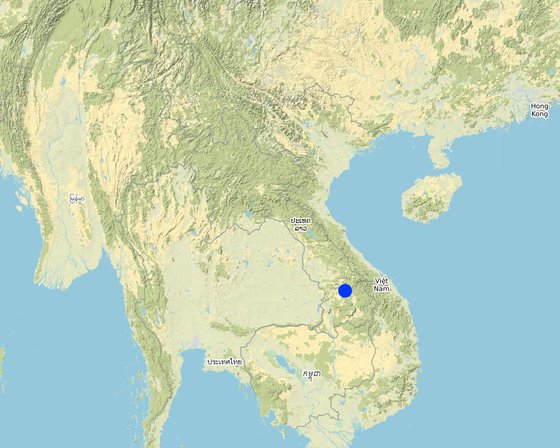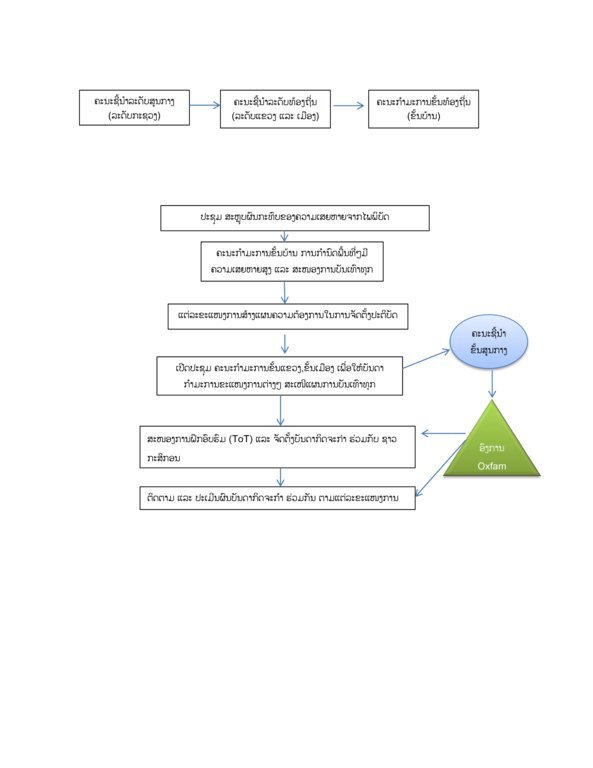



The disaster risk reduction project in upland communities was established after the Ketsana typhoon hit the southern region of Lao PDR in 2008, causing significant losses to assets, infrastructure, and agricultural land. The project was approved by the Ministry of Labour and Social Welfare, and Ministry of Planning and Investment to be implemented at community level through a project steering committee which included the deputy provincial governor. The district governor was the project director at the local level based on an action plan developed by the ministries concerned with assistance from Oxfam Australia. This action plan was aimed at disaster prevention and control. The project coordinators came from the relevant government agencies including the District Labour and Social Welfare Office, the District Agriculture and Forestry Office, the District Administration Office, the District Health Office, the District of Natural Resources and Environment Office, and mass organizations (Women’s Union, Youth Union, Trades Union, and Lao Front for National Construction). The key project aims are to increase understanding about disaster management, disaster risk reduction, and community resilience. The main activities to be implemented include emergency response during floods/droughts, reduction of impacts from disease outbreaks, livestock revolving funds, and village rice banks. In the agriculture sector, the project promotes integrated crop cultivation (maize, beans, lemons, etc), a particular rice planting method termed SRI (System of Rice Intensification), and household gardens. In addition, Oxfam Australia and the local government of Lao PDR in cooperation with Care International (Xekong Province), and the World Food Programme provided emergency response and relief, and sanitation. Although there are a number of organizations which have contributed to disaster risk reduction and emergency response, constraints remain such as the implementation of limited life projects, inadequate funding, and a lack of coordination in the province and districts.. Village Committees for Disaster Prevention and Control have been established with regular meetings and disaster awareness campaign activities implemented. The project outcomes demonstrated that the communities are satisfied with their active participation.

地点: Taouy district, Saravan province, 老挝人民民主共和国
启动日期: 2008
终止年份: 2014
方法的类型
| 该方法涉及哪些利益相关者/执行机构? | 指定利益相关者 | 说明利益相关者的角色 |
| 当地土地使用者/当地社区 | Farmer’s group | Implementer |
| 社区组织 | Village authorities and village organisation | Approve, certify and dissemination of key information |
| SLM专家/农业顾问 | District Agriculture and Forestry Office staffs | Supervise the project implementation and provide training |
| NGO | Oxfam Project Staffs | Supervise the project implementation and provide training |
| 地方政府 | Provincial Agriculture and Forestry Office and District of Agriculture and Forestry Office staffs | Leading, monitoring the implementation of the project and provide training |
| 国家政府(规划者、决策者) | Central Administrative Office in Vientiane and Ministries level. | Consultaition and approve the project implementation at national level. |
| 国际组织 | Oxfam International Office | Financial support |

决策是由......做出的
决策是基于
The fund management, water supply uses, rice bank, veterinary, chicken raising, aquaculture, rice production, disaster risk preparedness and response, typhoon, forest fires, disaster warning equipment.
A number of potentially appropriate activities have been modified to fit local conditions, such as: promotion economics / marketing of animal breeds that people never raised before.
local communities supplied labor and the project paid for this
Villagers
Project
Project
土地使用者的劳动力为
The end of project, there is no follow up activity but some activity were went well especially for the rice bank.
Some people have learned from the project and gained useful knowledge and experiences which has enabled them to find other employment opportunities.
The rice production and animal breeding groups are able to maintain their initiatives. Gravity fed water supply system, school, road have been supported by other development organizations.